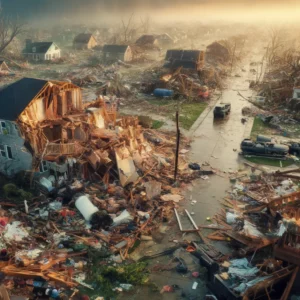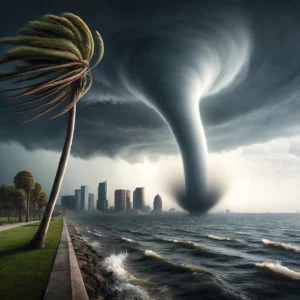Tornado-Spawning Thunderstorms Leave Trail of Destruction
A series of deadly storms, including tornado-spawning thunderstorms, swept across the Southern Plains and Ozark Mountains over the Memorial Day holiday weekend. At least 21 lives were lost across four U.S. states, and hundreds of buildings were damaged. The National Weather Service warns of more severe weather, with millions in the Northeast under a severe thunderstorm watch.
5 Key Points
- The death toll spans four states: eight in Arkansas, seven in Texas, four in Kentucky, and two in Oklahoma.
- Kentucky Governor Andy Beshear declared a state of emergency, reporting that devastating storms hit almost the entire state.
- In North Texas, a powerful tornado claimed at least seven lives, including two children, and injured nearly 100 people.
- President Joe Biden offered condolences and directed federal agencies to provide support as needed.
- Hundreds of thousands of Americans are without power due to the severe weather, and restoration efforts could take days in some areas.
States of Emergency and Federal Support
Governors of the affected states have declared states of emergency, with Kentucky Governor Andy Beshear reporting that the storms damaged 100 state highways and roads. The governor took to social media platform X (formerly Twitter) to express the severity of the situation, stating, “It was a tough night for our people.” He later elaborated in a press briefing that the devastating storms had impacted nearly the entire state.
In North Texas, Governor Greg Abbott revealed that at least seven people, including a 2-year-old and a 5-year-old from the same family, lost their lives when a powerful tornado struck communities near the Oklahoma border on Saturday night. The tornado also left nearly 100 people injured.
Arkansas Governor Sarah Huckabee Sanders reported that at least eight people died in her state due to the storms, including one individual with chronic obstructive pulmonary disease who passed away due to a lack of oxygen when the power went out.
President Joe Biden spoke with Oklahoma, Texas, and Arkansas governors, offering condolences and directing federal agencies to provide support as needed. The Federal Emergency Management Agency (FEMA) conducts damage assessments alongside state and local counterparts on the ground. The White House emphasized that President Biden has instructed federal agencies to assist as required.
Widespread Power Outages and Restoration Efforts
According to the PowerOutage.US tracking website, severe weather has left hundreds of thousands of Americans without power. In Kentucky alone, more than 160,000 customers are experiencing electricity outages. Governor Beshear cautioned that restoring power in some areas could take days, highlighting the extent of the damage caused by the storms.
Ongoing Threat of Severe Weather
The National Weather Service warns that additional storms are expected to move through the Ohio and Tennessee valleys, bringing damaging winds, large hail, more tornadoes, and heavy downpours capable of triggering flash floods. A severe thunderstorm watch has been issued for parts of New Jersey, New York, and Pennsylvania until Monday evening, affecting more than 30 million people in the Northeast as the storms move toward the East Coast.
The severe weather comes just days after a powerful tornado ripped through an Iowa town, killing four people, and more twisters touched down in Texas last week. These recent events underscore the increasing frequency and intensity of severe weather events across the United States.
Preparing for an “Extraordinary” Hurricane Season
As the U.S. recovers from the deadly Memorial Day weekend storms, the country is also preparing for what government forecasters have called a potentially “extraordinary” 2024 Atlantic hurricane season, set to begin next Saturday. The National Oceanic and Atmospheric Administration (NOAA) has predicted an above-average hurricane season, with the potential for 14 to 21 named storms, 6 to 10 of which could become hurricanes, and 3 to 5 of those possibly reaching Category 3 strength or higher.
The severe weather events are a stark reminder of the importance of preparedness and the need for swift response and support in the face of natural disasters. As communities across the affected states begin the recovery and rebuilding process, the focus turns to ensuring the safety and well-being of those impacted by the storms while also looking ahead to the potential challenges of the upcoming hurricane season.
Storms on Memorial Day Weekend FAQ
Q. How many states were affected by the deadly storms during the Memorial Day weekend?
A. The deadly storms claimed lives across four U.S. states: Arkansas, Texas, Kentucky, and Oklahoma.
Q. What is the storm’s total death toll as of Monday afternoon?
A. As of Monday afternoon, the storms have claimed at least 21 lives: eight in Arkansas, seven in Texas, four in Kentucky, and two in Oklahoma.
Q. What actions have the affected states taken in response to the storms?
A. Governors of the affected states have declared states of emergency, with Kentucky Governor Andy Beshear reporting that devastating storms hit almost the entire state, damaging 100 state highways and roads.
Q. How has the federal government responded to the deadly storms?
A. President Joe Biden spoke with the governors of Oklahoma, Texas, and Arkansas, offering condolences and directing federal agencies to provide support as needed. FEMA is on the ground conducting damage assessments alongside state and local counterparts.
Q. What is the forecast for the upcoming Atlantic hurricane season?
A. Government forecasters have warned of a potentially “extraordinary” 2024 Atlantic hurricane season, set to begin next Saturday. NOAA predicts an above-average season, with the potential for 14 to 21 named storms, 6 to 10 of which could become hurricanes, and 3 to 5 of those possibly reaching Category 3 strength or higher.
Citations:
Singh, K. (2024, May 28). U.S. storms kill at least 21 across four states on Memorial Day weekend. Reuters.






